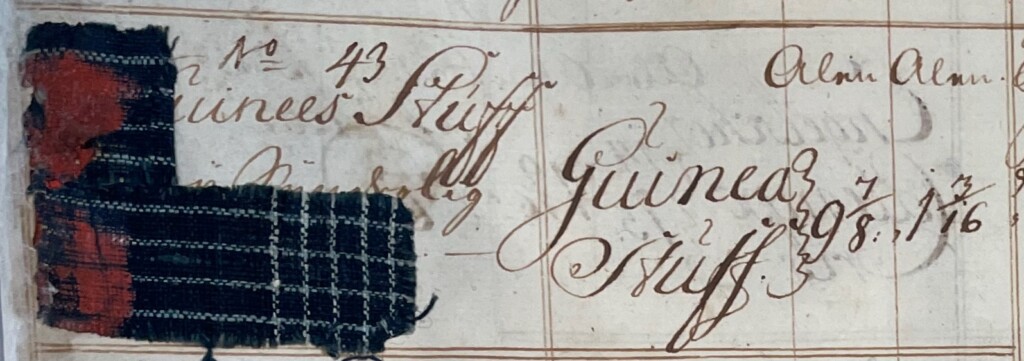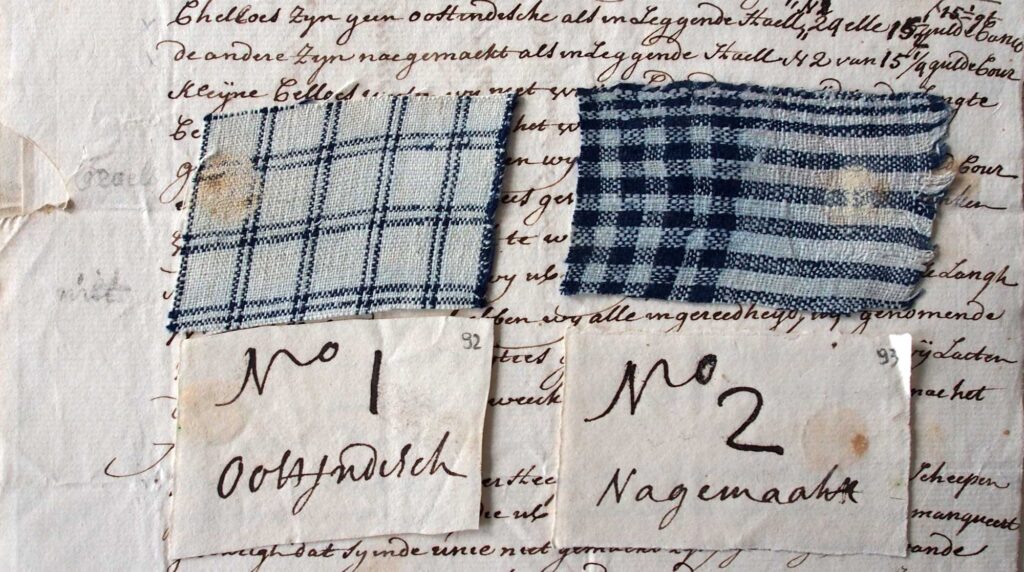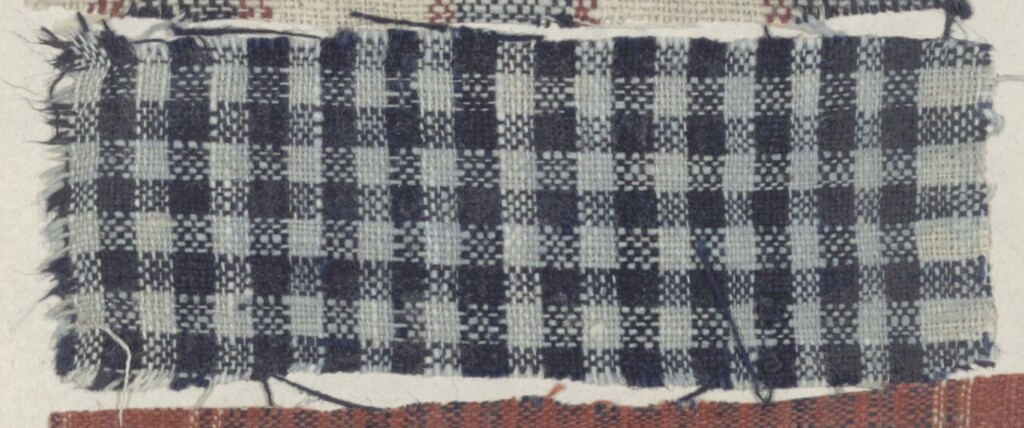Definition
Name Variants
Textiles, Modifiers, and Values
Choose a textile from the dropdown list on the upper left. Select modifier(s) for your selected textile, if any. The bar graph will generate visualizations that reflect your selections. X- and y-axis variables can also be changed.
A note about modifiers: The modifier dropdown list will include only those modifiers that relate to the selected textile. Choose OR to see results that match any of the selected modifiers. Choose AND to see results that match all of the selected modifiers. You can select more than one modifier in each field.
Essay
The term “guinea cloth” (often described simply as “guinees” in WIC and VOC documents) refers to a category of Indian-made cotton cloths that varied in color, pattern, and quality. While Company documents usually describe them only by color, extant samples and secondary sources suggest they could also be striped or checked (fig. 1).

Striped and checked patterns were created on the loom from dyed yarns, rather than piece-dyed. Guinea cloths could be bleached or raw, fine or coarse, which suggests they could be modified to accommodate different markets. Guinees were relatively inexpensive: one piece of guinea cloth, which could range in size from 35 to 50 meters, cost between 20 and 25 guilders per piece on average, or about .3 guilders per meter.[1] The WIC sometimes measured guinea cloth by the half piece.
In the eighteenth century, the VOC bought the bulk of their guinea cloth from merchants on the Coromandel Coast and in Sri Lanka (former Ceylon), but guinees were also purchased in Mocha (Yemen), the Malabar Coast, Bengal, and Java. Although guinees could be purchased at various ports, they were produced primarily on the Coromandel Coast and Gujarat.[2] These blue-and-white textiles were made from locally sourced cotton (sometimes shipped from Deccan, where it was plentiful) and dyed using indigo, which could produce a range of blue hues.[3] Looms and production varied from region to region, depending on available resources and local workshop practice.
The name “guinea cloth” suggests that these textiles were meant to be traded in West Africa, a region that Europeans referred to as the “Guinea Coast” in the early modern period. Indeed, between 1700 and 1724, the WIC shipped more than four thousand pieces of guinea cloth to Mauritania, Ghana, and Benin, and an additional ten thousand to Angola. Blue-and-white cloths became so popular and so essential to trade that knock-offs were made: the Zeeland Archives in Middelburg houses a 1753 letter from a textile trader that included two types of blue-and-white cloths, one labelled oostindische – an indication of its “authentic,” Asian provenance – and one labelled nagemaakte, or counterfeit.[4]
 For early modern Europeans, the association of blue-and-white cloth with people from the African continent was pervasive in both travel literature and art, representing a type of social categorization whereby textiles and geography were closely intertwined. An early seventeenth-century visitor to Senegal, for example, writes about seeing people wearing cotton robes “full of blue stripes, like feather bed tykes.”[5] In 1602 Pieter de Marees similarly describes the cotton shirts worn by “those in authority” as having “blue stripes, like ticking.”[6] Olfert Dapper (1636–89), on the other hand, although he had certainly never been to Africa himself, nevertheless describes a blue-and-white cloth that was woven in Benin, and other visitors describe similar cloths.[7] For these Europeans, then, the patterns they reported seeing in Africa may have resembled the bedding in the background of Esaias Boursse’s (1631–72) painting Interior with Woman Cooking in the Wallace Collection or a miniature pillow made for a dollhouse in the Rijksmuseum (see related images below).
For early modern Europeans, the association of blue-and-white cloth with people from the African continent was pervasive in both travel literature and art, representing a type of social categorization whereby textiles and geography were closely intertwined. An early seventeenth-century visitor to Senegal, for example, writes about seeing people wearing cotton robes “full of blue stripes, like feather bed tykes.”[5] In 1602 Pieter de Marees similarly describes the cotton shirts worn by “those in authority” as having “blue stripes, like ticking.”[6] Olfert Dapper (1636–89), on the other hand, although he had certainly never been to Africa himself, nevertheless describes a blue-and-white cloth that was woven in Benin, and other visitors describe similar cloths.[7] For these Europeans, then, the patterns they reported seeing in Africa may have resembled the bedding in the background of Esaias Boursse’s (1631–72) painting Interior with Woman Cooking in the Wallace Collection or a miniature pillow made for a dollhouse in the Rijksmuseum (see related images below).
Images from Dutch Brazil reinforced this association between blue-and-white cloth and Africa by the frequency with which enslaved Africans are depicted wearing blue-and-white striped or checked garments. Albert Eckhout (1610–55), the court painter to Governor-General Johan Maurits, painted a series of eight near-life-sized figures depicting people living in Brazil in relation to European notions of civility. Eckhout’s African Woman, one of the paintings in this series, wears a blue-and-white striped skirt made of cloth with resembles a textile called bajutapauts, a similarly priced blue-and-white textile that circulated in African markets, but could have been intended to represent any number of similar textiles, including guinea cloth or corroots. The drawings of Zacharias Wagener (1614–88), an amateur artist and WIC employee living in Brazil at the same time as Eckhout, also show enslaved men and women dressed in blue-and-white cloth.[8]



As Colleen Kriger and others have demonstrated, the European merchants who shipped blue-and-white textiles to the west coast of Africa were responding to a preexisting preference for these loom-pattern garments, which went back to at least the 10th century.[9] The association of blue-and-white garments with enslavement in visual imagery, therefore, reveals only the European desire to reinforce visually the status of the people they enslaved, belying the social importance these textiles had to the local communities in which they circulated. Cécile Fromont has shown how the Kongo elite “reinvented notions and expressions of prestige in the new Atlantic context” through the acquisition of foreign objects and textiles – especially blue-and-white textiles acquired through foreign trade.[10] Danielle Skeehan has likewise shown how guinea cloths circulating in the Caribbean acted as “material texts” for women and that these textiles were critical for articulating complex social identities.[11] Interestingly, Liza Oliver has demonstrated that there was also a market for guinea cloths in Europe, which our data supports: between 1700 and 1725, just under 1.5 million piece of guinea cloth—of various colors and qualities—are shipped to the Netherlands, but only about 15,000 are repackaged and sent to West Africa and Angola, suggesting that a large quantity continued to circulate in Europe.[12]
Although guinea cloth is typically associated with the blue-and-white cloths shipped to Africa discussed above, our data shows that they were also traded by the VOC in a number of Asian ports, including Japan and South Sumatra, among other regions.[13] Here, white guinea cloths were strongly preferred over blue and blue-and-white varieties. In fact, 45% of all guinea cloth circulating in the VOC/WIC between the years 1700 and 1725 were white. Of these white textiles, less than 10% were destined for the west coast of Africa. 42% of these white cloths were shipped to the Dutch Republic, about 30% were traded to various locales in Southeast Asia, 8% to Japan, 4% to South America (Essequibo), and the remainder to other Indian Ocean markets. In Batavia, white textiles—instead of, or sometimes in addition to, blue-and-white clothing—were often used to signify enslavement. Miki Sigiura, writing on early examples of readymade clothing, draws our attention to the 1750 regulations for supplying clothing to orphaned children and enslaved people in Batavia’s orphanage in 1750. These include specific mention of white or plain shirts of guinea cloth for enslaved women and for orphaned children, while enslaved men wore brown-bleached salempores, another plain, light cloth.[14] The evocation of a person’s status as free or enslaved through the wearing of a white shirt is much more difficult to trace in the visual culture than the more specific blue-and-white cloth, and this, along with the complicated world of Dutch slavery in Asia begs further examination.
CA & MK
Footnotes
[1] Piece size based on Ruurdje Laarhoven, “The Power of Cloth : The Textile Trade of the Dutch East India Company (Voc) 1600-1780,” (Australian National University, 1994), appendix. Price range based on WIC documents, NL-HaNA_1.05.01.02, inv. nos. 1282-1304.
[2] For the first part of the seventeenth century, see Om Prakash, The Dutch Factories in India, 1617 to 1623 (Munshiram Manoharlal Publishers, 1984) and Om Prakash, The Dutch Factories in India 1624-1627 (Manohar Publishers, 2007).
[3] John Guy, Woven Cargoes. Indian Textiles in the East (New York: Thames and Hudson, 1998), 19-21.
[4] For more on the textiles transported by Dutch ships to West African, see the digital project organized by the Zeeland Archives, “On Board the Unity,” https://eenigheid.slavenhandelmcc.nl/trajecten-van-de-reis-en/afrika-en/samenstelling-cargazoen/textiel-slavenhandel/?lang=en.
[5] S. Purchas, Purchas his Pilgrims […] (London, 1625).
[6] Pieter de Marees, Description and historical account of the Gold Kingdom of Guinea, A. van Dantzig and A. Jones (trans.), (Oxford/New York: Oxford University Press, 1987), 11.
[7] F.C. Ryder, Benin and the Europeans, 1485-1897 (London: Longmans, 1969), 93-94. Olfert Dapper’s Naukeurige Beschrijvinge der Africaensche Gewester (Accurate Description of the Regions of African, 1668), which is based on the texts of earlier authors—especially Pieter de Marees—is an important source for Benin, but one that should be treated cautiously. On Dapper, see Adam Jones, “Decompiling Dapper: A Preliminary Search for Evidence,” History in Africa 17 (1990): 171-209; and Elizabeth Sutton, Early Modern Dutch Prints of Africa (Routledge, 2017).
[8] On the relationship between these images and Indian-made blue-and-white textiles, see Carrie Anderson, ““From Textile to Text: Cloth, Slavery, and the Archive in the Dutch Atlantic,” in Making Worlds. Global Invention in the Early Modern Period, eds. Angela Vanhaelen and Bronwen Wilson (University of Toronto Press), forthcoming; Carrie Anderson (Contributions by Marsely Kehoe), “Textiles and Trade in the Dutch Atlantic World: Albert Eckhout’s African Man and Woman,” in Art Museums and the Legacies of the Dutch Slave Trade, S. Mallory, J. Sheers Seidenstein, K. Jackson, and R. Burke, eds. (Brill), forthcoming. Carrie Anderson, “From ‘grof’ to ‘fijn’: Blue-and-White Textiles in the Dutch Atlantic Market” for Bloomsbury Encyclopedia of World Textiles (Volume 6: Trade and Industry), forthcoming.
[9] See Kriger, Cloth in West African History (Lanham: AltaMira Press, 2006); see also Kriger,“Guinea Cloth,” in The Spinning World: A Global History of Cotton Textiles, 1200-1850, Prasannan and Riello, eds. (Delhi: Primus Books, 2012), 105-126. R. Bedaux and R. Bolland, “Medieval Textiles from the Tellem Caves in Central Mali, West Africa,” Textile Museum Journal, v. 19-20 (1980-81): 65-74.
[10] Cécile Fromont, The Art of Conversion. Christian Visual Culture in the Kingdom of Kongo (Chapel Hill: University of North Carolina Press, 2014), chap. 3.
[11] Danielle Skeehan, The Fabric of Empire. Material and Literary Cultures of the Global Atlantic, 1650-1850 (Baltimore: Johns Hopkins University Press, 2020), 72-89. See also, the brilliant study by Anna Arabindan-Kesson, Black Bodies, White Gold. Art, Cotton, and Commerce in the Atlantic World (Durham and London: Duke University Press, 2021).
[12] Liza Oliver, Art, Trade, and Imperialism in Early Modern French India (Amsterdam: Amsterdam University Press, 2019), 74-91.
[13] See also Oliver, 74-91.
[14] Miki Sugiura, “The Economies of Slave Clothing in the Eighteenth-Century Dutch Cape Colony.” 104–129 in Dressing Global Bodies: The Political Power of Dress in World History, ed. Beverly Lemire and Giorgio Riello (London: Routledge, 2019): 107-110.









